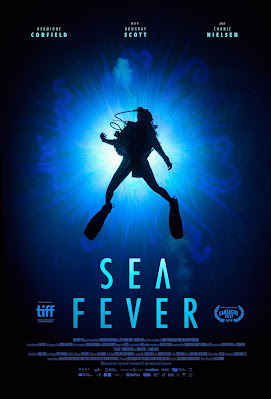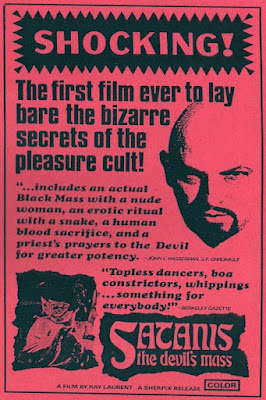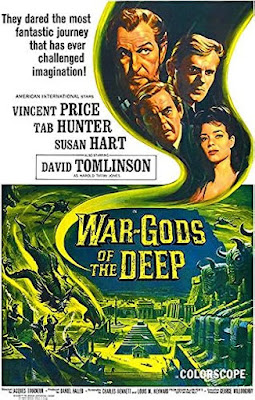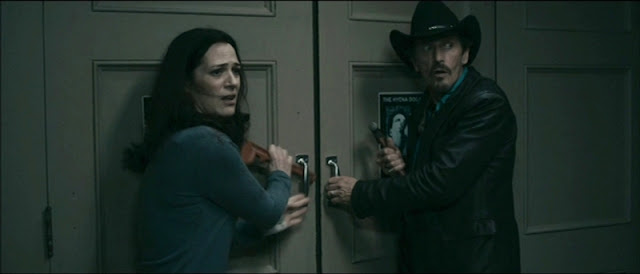(1965) Directed by Stephen C.
Apostolof (as A.C. Stephen); Screenplay by Edward D. Wood, Jr.; Based on
the novel by Edward D. Wood, Jr.; Starring: Criswell, Fawn Silver, Pat
Barrington, William Bates and John Andrews; Available on Blu-ray and DVD
Rating: **½
“I am Criswell. For years, I have told the almost
unbelievable, related the unreal and showed it to be more than a fact. Now I
tell a tale of the threshold people, so astounding that some of you may faint. This
is a story of those in the twilight time. Once human, now monsters, in a void
between the living and the dead. Monsters to be pitied, monsters to be
despised. A night with the ghouls, the ghouls reborn from the innermost depths
of the world.” – Criswell (as the Head Ghoul)
"Hey, are we even in the right movie?"
We
live in a wondrous age when so many cinematic obscurities are available to
purchase on DVD and Blu-ray through so-called “boutique” labels (Indicator,
Severin, etc…). Suddenly, movies that were lost, forgotten, or simply hard to
find are miraculously available to clutch in our grubby little paws. As with
everything, however, it’s a blessing and a curse, which is a good way to
describe Edward D. Wood Jr.’s Orgy of the Dead. While Mr. Wood didn’t
direct (those chores went to Stephen C. Apostolof, aka: A.C. Stephen), he wrote
the script, based on his novel with the same title, and was a fixture on the film
set (providing casting assistance and as a production manager). Apostolof’s
first (and best known) collaboration with Wood took many of the themes we’ve
come to expect from Wood, transplanting them to the “nudie cutie” genre (or
should I say, “nudie ghoulie”?). The movie was barely a blip on the radar when
it was released, with a tagline, “Are you heterosexual?” that seemed more like
a taunt to its potential audience (assuming they knew what “heterosexual”
meant) rather than an invitation to see it in the theater.

The
inimitable Criswell*/** rises out of his coffin to greet the audience as our
guide to the hoary netherworld, the Emperor of the Dead. Meanwhile, our
slack-jawed “protagonists,” Shirley and Bob (Pat Barrington and William Bates)
are out for an evening drive (okay, day-for-night drive) on a treacherously
twisty road, when Bob loses control and crashes. The shaken but not visibly
injured couple stumble into a graveyard, and thus begins their night of terror,
as they witness the damned receiving their just desserts. The Emperor and his
mistress, The Black Ghoul (Fawn Silver), preside over the night’s festivities,
judging each condemned participant like a beauty pageant. Only Ed Wood would
think to tell what basically amounts to a series of morality tales told through
striptease acts.
*
Fun Fact #1: According to Ed Wood biographer, Rudolph Grey, Criswell’s cape in
the film was previously worn by Bela Lugosi in Abbott and Costello Meet
Frankenstein (1948).
**
Fun Fact #2: Criswell was a constant source of irritation for director Stephen
C. Apostolof, as he didn’t memorize his lines. During filming, Criswell read
from cue cards, held by Ed Wood.
Our "Heroes"
The
Emperor metes out the ultimate judgment awaiting several women in the afterlife,
but first they must dance for him. Unfortunately for the poor audience, it gets
redundant after a while (lather, rinse, repeat), with one bump and grind act
(performed by professional exotic dancers) blending into another, albeit with a
horror veneer (Throw in a fog machine, scatter a few skulls around, and voilà,
instant horror!). One of the more imaginative acts, inspired by Goldfinger,
features Pat Barrington (in a second role and a blonde wig) as a woman who was
obsessed with gold so much, she’s dipped in a bubbling cauldron of the shiny ore.
In another sequence, an “indigenous” woman (Bunny Glaser) is consumed by flames.
Whoever said cultural appropriation couldn’t be sexy? Well… everyone, but that
didn’t stop Apostolof and Wood from presenting their vision of hell. The
preponderance of women in various states of undress begs the question, however,
what happens to men who committed some sort of wrong during their lives? Are
they also condemned to shake their moneymaker in the afterlife, or do they
somehow get a free pass? Or is that what’s going on in an adjacent crypt? So
many burning questions, so few answers. But I digress…
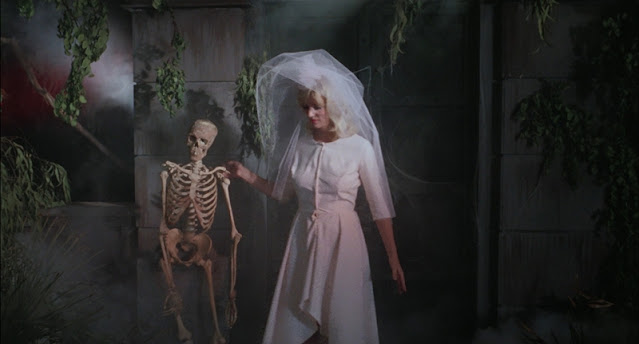
The
Emperor and Black Ghoul’s captive audience, Shirley and Bob watch on in what could
be construed as horror and disgust. Perhaps Barrington and Bates, were aiming
for conflicted, but instead they look merely confused. I suppose you can’t
place all the blame on the actors’ apparent lack of talent (What’s their motivation?
You got me). This is where Apostolof needed to step in as the director,
providing the necessary input to adjust their performances. Then again, you can
only do so much with the hand that’s dealt to you. One performer who needed little
provocation to get in character was Criswell being (ahem) Criswell.* Expect
multiple shots of Criswell and his ghoul friend reacting to the various acts
(“This pleases me…”), yet they’re rarely in the same shot as the dancers, leading
me to suspect they filmed their scenes on different days from the dancers. The
Black Ghoul,** who resembles the missing link between Vampira and Elvira, doesn’t
have much dialogue, but has a presence, nonetheless, as the Emperor’s mostly
silent partner. She has the hots for Shirley, but vanishes in a puff of smoke
before she can act on her presumably libidinous impulses.
*
Fun Fact #3: Before he started his psychic schtick, he would appear on TV
commercials in Los Angeles in the early 1950s, shilling Criswell Family
Vitamins. Soon, his media presence would morph into a more lucrative job as a
psychic with the show, Criswell Predicts.
**
Fun Fact #4: Fawn Silver (married to showbiz attorney Ron Silver), insisted on
having no nude scenes, and brought her own hairdresser and makeup person on the
set.
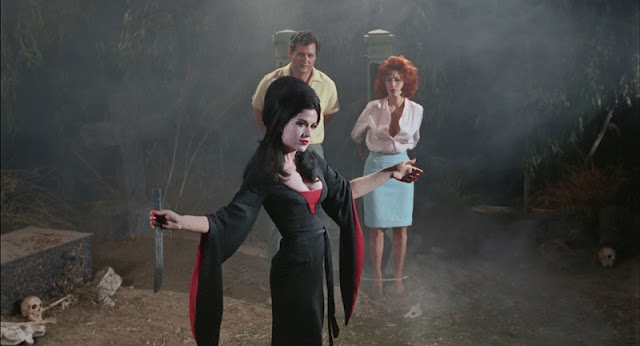
According
to filmmaker Frank Henenlotter (who provided the commentary, along with Rudolph Grey), Orgy of the Dead was something of an
anomaly when it was released in 1965, since the age of the nudie cutie had
already passed. On the other hand, the fact that it was somewhat out of touch
with the trends of the time (when other independent genre filmmakers had moved
on to the “roughies”) scarcely seems to matter now – it exists as an almost
quaint curio from a bygone era. Perhaps the most surprising thing about Orgy of
the Dead is how good it looks, thanks to camerawork by Robert Caramico, and the
gorgeous transfer from the twisted folks at Vinegar Syndrome. Although Ed Wood
didn’t direct the film, it has his indelible mark on everything, including the choice
dialogue you’ve come to expect, with the added bonus of Criswell in color.
Admittedly, it’s also a bit of a slog to sit through, with the repetitive strip
acts, but depending on your tolerance for kitsch, it might be worth a peek. If
you’re an Ed Wood completist, it’s essential viewing. For all others, proceed
cautiously.
Sources
for this article: Vinegar Syndrome Blu-ray commentary by Rudolph Grey and Frank
Henenlotter; Nightmare in Ecstasy by Rudolph Grey; Findagrave.com

